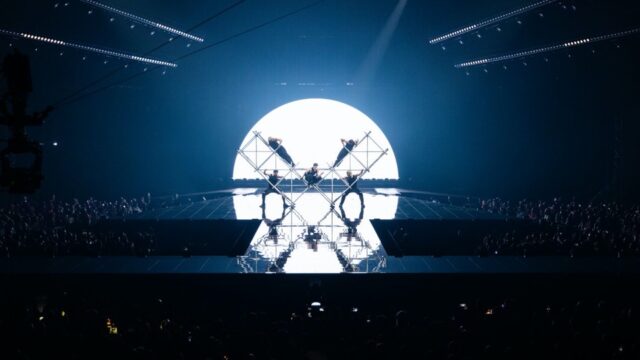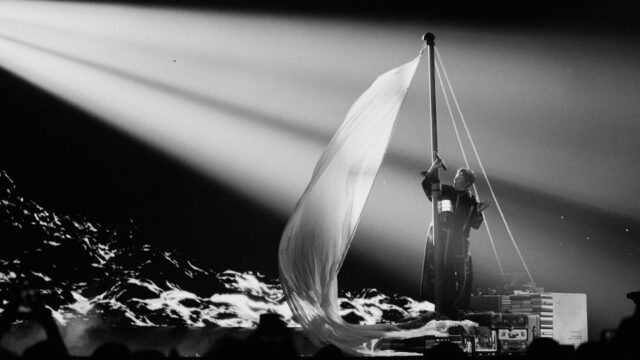Prior to Eurovision Week, Austria’s Johannes ‘JJ’ Pietsch was tipped to win because of his remarkable vocals. During Eurovision Week, ‘Wasted Love‘ gained a new dimension with its staging, led by Creative Director Sergio Caen. He burst to prominence last year when he developed the dark and gothic staging for Ireland’s Bambie Thug. Austria’s JJ received a similarly distinctive visual treatment to ‘Doomsday Blue‘, a black-and-white recreation of a storm on stage, complete with gusts of wind, thunderous clouds, and a vicious whirlpool threatening to drag the singer into the briny deep.
But a song’s staging isn’t as simple as the choreography and props. In St. Jakobshalle, the floor and walls were also giant screens, ready for video projections that help to enhance the performance. And that’s where the work of a company like Boxcat Studio, which develops the animations that appear behind musicians at festivals and award shows, comes in. During Eurovision Week, I had the chance to talk to Alex Wilson, Director and Co-Founder of Boxcat Studios.
Boxcat Studios has a background in EDM, festivals, and stadium shows. It became involved with Eurovision last year when they provided the visuals for Bambie Thug’s staging. “It was just different to what every other Eurovision was; the polar opposite,” Wilson said. “It was dark, it was really cool.”
Boxcat’s Eurovision Adventure In Basel
This year, Boxcat worked to provide the visuals for two separate stagings, Cyprus and Austria. I asked about the challenges of working with the visual look of JJ’s staging. At a Contest so associated with bright colours, was it hard to be working solely with black and white animation?
“I mean, I’m not a fan of colour really in general,” Wilson noted. “Black and white is my go-to. It’s generally quite easy to make look good because it’s high contrast, which eliminates a lot of the issues you’re going to get with adding colours.”
And yet, while this year’s Eurovision stage had ample areas for extra projection graphics – the floor, the proscenium arch, and the mountainous backdrops – these were not used for JJ’s performance. “We will focus on what’s going to be seen, and we never really had any intention to use any of the proscenium or the floor that went down into the audience,” Wilson said. “How can we take this massive arena and basically bring all the focus into one individual place? I think less is going to be more in that case”
Indeed, Wilson would prefer if people weren’t actually aware of the work the studio put in. “My job is done well if people don’t notice the video. It just exists and it’s just there…It’s about the artist on stage and the country we’re supporting.”

Theo Evan, Cyprus 2025 (image: EBU/Corinne Cumming)
I confessed that I had not noticed Boxcat’s work at all for Cyprus; it was only after rewatching that I saw the pops of colour and geometric shapes that appeared behind Theo Evan, subtly enhancing his performance.
Even with the focus being on the television show, though, there are still thousands of people in the arena who are experiencing Boxcat’s graphics. How do they balance between the two? “Generally, if we’re happy with it, it will look good there and it will look good when it’s broadcast,” Wilson noted, “From experience, I think as long as we do what we’re good at, it will always look good.”
What Does It Take to Deliver Eurovision’s Video Graphics?
It’s only a few months between the time when the Eurovision Song Contest songs are submitted to the EBU, and when they appear on stage. How long does it take to pull the whole design for the animated graphics together for rehearsals? Wilson noted that teams are provided in advance with a 3-D representation of the stage, which allows them to get a sense of what things will look like for the audience. “We know how everything’s going to look roughly in camera as well, basically, in pre-visualization, where we can see everything as we make it.”
There was a clear vision for JJ’s look and feel from the start, with the stormy look. “I was a little bit hesitant because [the water effects] are quite hard to do, especially at that scale for the Eurovision screen,” Wilson said. “Which meant terabytes of simulation data just to get that to work. There was a lot of backwards and forwards with us and Sergio on how things look and move on stage, but it wasn’t too difficult once you got moving. The narrative was the most important thing.”
“Timelines are probably the hardest challenge. I had, I think, over a week to get the v1 [first version] in,” Wilson recalls. Then there are the rehearsals, after which there is some limited amount of time to make changes. “But because of the renders and the simulation time, we had basically one shot at getting it right.”

JJ, Austria 2025 (image: EBU/Alma Bengtsson)
Despite that, there were some changes to JJ’s staging that did come out in performance; namely, the lighthouses emerging from the water. “Two or three years ago, we just couldn’t have done it, but nowadays, we have certain tools that allow us to make these sort of changes very quickly.” If you rewatch the performance, you’ll see the way the physical stage works with the computer graphics – with the lights in the arena acting as the beacons for the illustrated lighthouses.
Wilson had praise for the technical team at the EBU. “Eurovision is professional. Everyone has an idea of what the end goal is.” He talked about the rehearsal schedule, during which time the production team work with each country’s act to map out every single camera shot. “The camera team are probably the best in the world. Every single camera shot is planned and scripted so it’s going to be the same on the night as it is in rehearsals. So that really makes things a lot easier from our side, because we know what’s going to be in shot.
“We know what to focus on, and we’re not focusing on random stuff you won’t see when it’s broadcast.”
How Does Someone End Up Doing This?
As always, when it comes to Eurovision, I’m fascinated by the sheer amount of people who work on the Song Contest, and the number of jobs that it takes to make the show work. To be honest, I had never thought about the person who develops the animation that plays as part of the staging, and I asked Wilson how he got into this field.
“I just sort of fell into it at a very young age – started like 14, 15 pushing fly cases about.” He noted that there are more courses for it now, as well as a growing community around production and travelling. “There’s always a way to get involved in this industry. I think it’s a good one to get into. There’s a lot of reward, but it is a lot.” In fact, the demands of the job often mean that Wilson is traveling or working during Eurovision, and often misses the show itself, but he’ll catch up with the performances on YouTube.
I noted that a billion people were going to be seeing his lighthouses on the screen when JJ was performing. “It’s not stressful,” Wilson said. “There’s nothing I can do about it now. Whatever happens happens…Hopefully it does go all the way, because I think it’s the more unique looking show.”

JJ, Austria 2025 (image: EBU/Sarah Louise Bennett)









